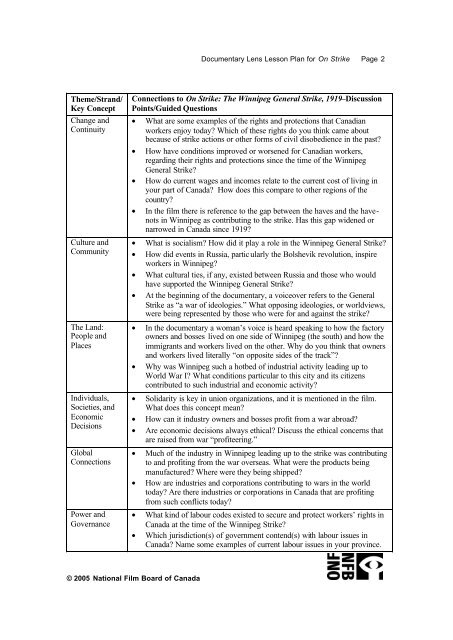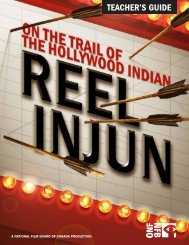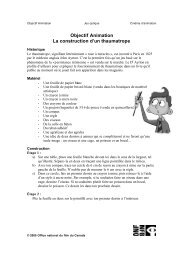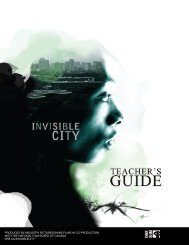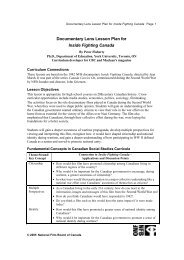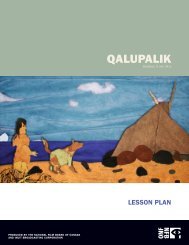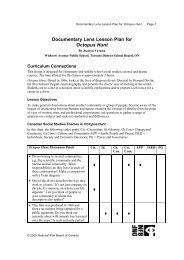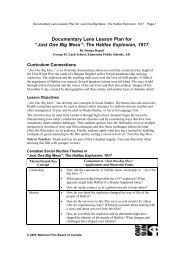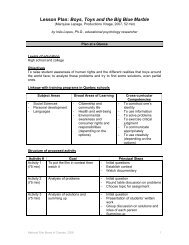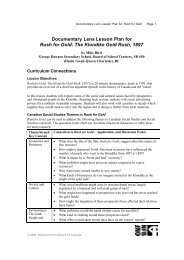Documentary Lens Lesson Plan for On Strike - Office national du film ...
Documentary Lens Lesson Plan for On Strike - Office national du film ...
Documentary Lens Lesson Plan for On Strike - Office national du film ...
Create successful ePaper yourself
Turn your PDF publications into a flip-book with our unique Google optimized e-Paper software.
<strong>Documentary</strong> <strong>Lens</strong> <strong>Lesson</strong> <strong>Plan</strong> <strong>for</strong> <strong>On</strong> <strong>Strike</strong> Page 2Theme/Strand/Key ConceptChange andContinuityCulture andCommunityThe Land:People andPlacesIndivi<strong>du</strong>als,Societies, andEconomicDecisionsGlobalConnectionsPower andGovernanceConnections to <strong>On</strong> <strong>Strike</strong>: The Winnipeg General <strong>Strike</strong>, 1919–DiscussionPoints/Guided Questions• What are some examples of the rights and protections that Canadianworkers enjoy today? Which of these rights do you think came aboutbecause of strike actions or other <strong>for</strong>ms of civil disobedience in the past?• How have conditions improved or worsened <strong>for</strong> Canadian workers,regarding their rights and protections since the time of the WinnipegGeneral <strong>Strike</strong>?• How do current wages and incomes relate to the current cost of living inyour part of Canada? How does this compare to other regions of thecountry?• In the <strong>film</strong> there is reference to the gap between the haves and the havenotsin Winnipeg as contributing to the strike. Has this gap widened ornarrowed in Canada since 1919?• What is socialism? How did it play a role in the Winnipeg General <strong>Strike</strong>?• How did events in Russia, partic ularly the Bolshevik revolution, inspireworkers in Winnipeg?• What cultural ties, if any, existed between Russia and those who wouldhave supported the Winnipeg General <strong>Strike</strong>?• At the beginning of the documentary, a voiceover refers to the General<strong>Strike</strong> as “a war of ideologies.” What opposing ideologies, or worldviews,were being represented by those who were <strong>for</strong> and against the strike?• In the documentary a woman’s voice is heard speaking to how the factoryowners and bosses lived on one side of Winnipeg (the south) and how theimmigrants and workers lived on the other. Why do you think that ownersand workers lived literally “on opposite sides of the track”?• Why was Winnipeg such a hotbed of in<strong>du</strong>strial activity leading up toWorld War I? What conditions particular to this city and its citizenscontributed to such in<strong>du</strong>strial and economic activity?• Solidarity is key in union organizations, and it is mentioned in the <strong>film</strong>.What does this concept mean?• How can it in<strong>du</strong>stry owners and bosses profit from a war abroad?• Are economic decisions always ethical? Discuss the ethical concerns thatare raised from war “profiteering.”• Much of the in<strong>du</strong>stry in Winnipeg leading up to the strike was contributingto and profiting from the war overseas. What were the pro<strong>du</strong>cts beingmanufactured? Where were they being shipped?• How are in<strong>du</strong>stries and corporations contributing to wars in the worldtoday? Are there in<strong>du</strong>stries or corporations in Canada that are profitingfrom such conflicts today?• What kind of labour codes existed to secure and protect workers’ rights inCanada at the time of the Winnipeg <strong>Strike</strong>?• Which jurisdiction(s) of government contend(s) with labour issues inCanada? Name some examples of current labour issues in your province.© 2005 National Film Board of Canada


